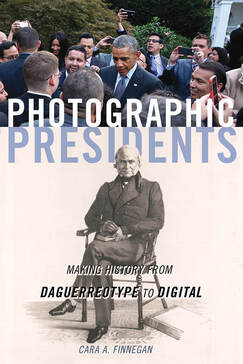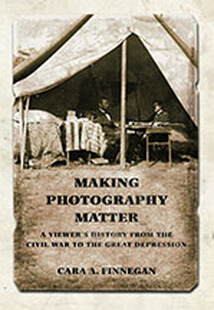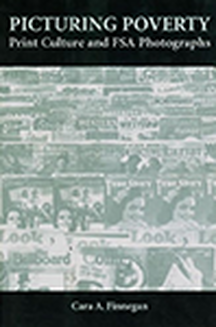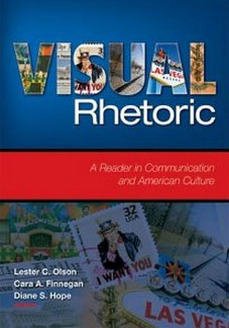books

Cara A. Finnegan, Photographic Presidents: Making History from Daguerreotype to Digital. University of Illinois Press, 2021.
Photographic Presidents examines how photography and the presidency grew up together.
Throughout U.S. history, presidents have participated in photography as subjects, producers, and consumers of photographs. Yet surprisingly, no one has written a comprehensive history of the ways that presidents have engaged with photography. Photographic Presidents is the first study of how presidents shaped and participated in transformative moments in the history of the medium: the rise of the daguerreotype portrait after 1839, the dawn of the “halftone era” in the late nineteenth century, the emergence of so-called “candid camera” photography in the late 1920s, and the digital revolution of the early twenty-first century. From daguerreotypes to selfies, from the earliest photographs printed in newspapers to online slideshows, technological developments transformed our practices of photography and introduced new visual values to the medium.
Find information about upcoming events and news about Photographic Presidents HERE.
"Informative, knowledgeable, and enjoyable. . . . a valuable addition to presidential history." (Foreword Reviews)
"Captivating. . . . Broad in scope and rich in anecdotal detail, this will please photography and history buffs." (Publishers Weekly)
"A valuable resource for students of both American politics and the history of photography." (Booklist)
"Fascinating dissection." (AirMail)
"Interesting and informative." (Journal of American Culture)
"Well-written and engaging." (Journal of American History)

Cara A. Finnegan, Making Photography Matter: A Viewer's History from the Civil War to the Great Depression. University of Illinois Press, 2015.
Finnegan asks how late nineteenth and early twentieth century Americans viewed photographs in times of national crisis and dramatic social change. Studies of photography's historical viewers are rare, and with good reason: it is not easy to access the experiences of historical viewers. Finnegan tackles this methodological problem by seeking out those moments when viewers shared their responses to photographs with others in their communities. She analyzes letters, newspaper and magazine articles, books, and comments left at exhibits to show how viewers mobilized their beliefs about photography into political arguments about war, child labor, economic depression, and shifting national identity. Overall, she shows that photography played an important role in helping Americans navigate public crises and social change.
"Finnegan digs into an important and under-examined aspect of the 'invasion' of photographic representation into public and private life. Recommended."--Choice
Winner of the National Communication Association's Winans-Wichelns Memorial Award for Distinguished Scholarship in Rhetoric and Public Address, 2016.
Winner of the Outstanding Book Award from the Visual Communication Division of the National Communication Association, 2015.
Reviewed by Quarterly Journal of Speech (2018), Rhetoric & Public Affairs (2018), Rhetoric Society Quarterly (2018), Journal of American Studies (2017), Technology and Culture (2017), Journal of American History (2016), American Historical Review (2016), Annals of Iowa (2016), Journal of Southern History (2016), Society for the History of the Gilded Age and Progressive Era (2015).
Finnegan asks how late nineteenth and early twentieth century Americans viewed photographs in times of national crisis and dramatic social change. Studies of photography's historical viewers are rare, and with good reason: it is not easy to access the experiences of historical viewers. Finnegan tackles this methodological problem by seeking out those moments when viewers shared their responses to photographs with others in their communities. She analyzes letters, newspaper and magazine articles, books, and comments left at exhibits to show how viewers mobilized their beliefs about photography into political arguments about war, child labor, economic depression, and shifting national identity. Overall, she shows that photography played an important role in helping Americans navigate public crises and social change.
"Finnegan digs into an important and under-examined aspect of the 'invasion' of photographic representation into public and private life. Recommended."--Choice
Winner of the National Communication Association's Winans-Wichelns Memorial Award for Distinguished Scholarship in Rhetoric and Public Address, 2016.
Winner of the Outstanding Book Award from the Visual Communication Division of the National Communication Association, 2015.
Reviewed by Quarterly Journal of Speech (2018), Rhetoric & Public Affairs (2018), Rhetoric Society Quarterly (2018), Journal of American Studies (2017), Technology and Culture (2017), Journal of American History (2016), American Historical Review (2016), Annals of Iowa (2016), Journal of Southern History (2016), Society for the History of the Gilded Age and Progressive Era (2015).

Cara A. Finnegan, Picturing Poverty: Print Culture and FSA Photographs. Smithsonian Books, 2003.
"Picturing Poverty . . . explores a moment in American history when visual images took center stage as the nation struggled with economic, political, and social strife. By striving to understand the original context of the photographs, Finnegan sheds new light on the meanings of poverty, the Depression, and the various roles of the media. At once a persuasive analysis of FSA images and a balanced commentary on the role of the media, Picturing Poverty is above all a look into the difficult issue of how the mass media presents social issues to Americans." (From Smithsonian Books)
Winner of the National Communication Association's Diamond Anniversary Book Award, 2004.
"Picturing Poverty . . . explores a moment in American history when visual images took center stage as the nation struggled with economic, political, and social strife. By striving to understand the original context of the photographs, Finnegan sheds new light on the meanings of poverty, the Depression, and the various roles of the media. At once a persuasive analysis of FSA images and a balanced commentary on the role of the media, Picturing Poverty is above all a look into the difficult issue of how the mass media presents social issues to Americans." (From Smithsonian Books)
Winner of the National Communication Association's Diamond Anniversary Book Award, 2004.

Lester C. Olson, Cara A. Finnegan, and Diane S. Hope, eds. Visual Rhetoric: A Reader in Communication and American Culture. Sage, 2008.
Visual Rhetoric introduces advanced undergraduate and graduate students to the range of scholarship on visual rhetoric in the field of Communication. The book presents twenty previously published scholarly essays that are organized into an original conceptual apparatus emphasizing the variety of rhetorical actions in which visual images participate.
Contributors are Thomas Benson, Barbara Biesecker, Carole Blair, Dan Brouwer, Dana Cloud, Kevin DeLuca, Anne Demo, Janis Edwards, Keith Erickson, Cara Finnegan, Bruce Gronbeck, Robert Hariman, Christine Harold, Ekaterina Haskins, Diane Hope, Judith Lancioni, Margaret LaWare, John Lucaites, Neil Michel, Charles Morris, Lester Olson, Shawn Parry-Giles, Ronald Shields, John Sloop, Nathan Stormer, Reginald Twigg, and Carol Winkler.
Visual Rhetoric introduces advanced undergraduate and graduate students to the range of scholarship on visual rhetoric in the field of Communication. The book presents twenty previously published scholarly essays that are organized into an original conceptual apparatus emphasizing the variety of rhetorical actions in which visual images participate.
Contributors are Thomas Benson, Barbara Biesecker, Carole Blair, Dan Brouwer, Dana Cloud, Kevin DeLuca, Anne Demo, Janis Edwards, Keith Erickson, Cara Finnegan, Bruce Gronbeck, Robert Hariman, Christine Harold, Ekaterina Haskins, Diane Hope, Judith Lancioni, Margaret LaWare, John Lucaites, Neil Michel, Charles Morris, Lester Olson, Shawn Parry-Giles, Ronald Shields, John Sloop, Nathan Stormer, Reginald Twigg, and Carol Winkler.